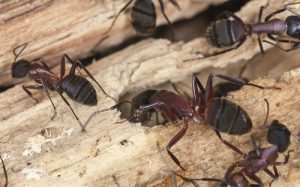Carpenter Ant Damage to Wood – How Bad Can it Be?
By Chris Williams on December 5, 2011.
Q. We were told by another pest control company that we have carpenter ants in some roof joists. My husband doesn’t want to spend the money to have the ants exterminated. He says it’s no big deal, that everyone has ants. How much wood damage can carpenter ants do?
A. Compared to other serious wood invaders like termites and powderpost beetles, carpenter ants are considered rather minor in terms of the damage they do to wood…in most areas of the country. However, two areas hard hit by carpenter ants are the Pacific Northwest and the Northeastern U.S. where carpenter ants are a serious problem.
In most cases, carpenter ants usually do not do serious structural damage unless they are ignored (or undiscovered) for a long time. Serious damage can easily occur in recreational areas like campgrounds where buildings may not be used for months at a time. Who knows how long your carpenter ants have been working, but ignoring them is not a good idea. Carpenter ants often start their infestation in wood that has been damp or is decaying (you may have a roof leak), but then they can move into sound, dry wood.
 Large colonies are capable of weakening studs, joists, and structural timbers. Often, some outside stress on the damaged wood such as a wind storm or snow accumulation on a roof is what ultimately causes the damaged structural member to give out. Most of the damage occurs during the warm summer months when carpenter ants are most active. New houses are attacked less often than older homes, presumably because older homes are more likely to have deteriorating wood and moisture problems.
Large colonies are capable of weakening studs, joists, and structural timbers. Often, some outside stress on the damaged wood such as a wind storm or snow accumulation on a roof is what ultimately causes the damaged structural member to give out. Most of the damage occurs during the warm summer months when carpenter ants are most active. New houses are attacked less often than older homes, presumably because older homes are more likely to have deteriorating wood and moisture problems.
Carpenter ants are often first noticed when the colony sends out winged swarmers. This doesn’t happen until the colony has 2,000-3,000 ants and is already 3 to 6 years old. There is usually no external evidence of carpenter ant damage on infested wood except for some slit-like openings used to eject frass and other debris from the nest. The first sign may be piles of sawdust-like frass below the nest site. Damage is usually first discovered when the wood surface is broken open. Then you will see the galleries inside that have a smooth, sandpapered appearance.
Carpenter ants don’t actually eat the wood, they just excavate it for nest sites. So, carpenter ants can sometimes nest in buildings without even attacking the wood. If they find suitable small voids and cavities that can serve as nest sites, there may be no need to chew into wood to create nests. They also sometimes excavate nests in foam or fiberglass insulation instead of in wood.
Sight unseen, it’s impossible to estimate how much damage the ants could do to your home. That depends on the size of the colony, where they’re nesting, the extent of the current infestation, the condition of the wood they’re infesting, and other factors such as temperature and humidity. You should at least try to talk your husband into having a thorough inspection to determine the extent of the infestation (if the previous company didn’t do so). Then you can make your decision based on that information. Give Colonial a call. We can send out one of our carpenter ant experts to help.